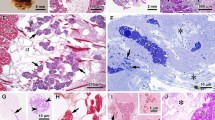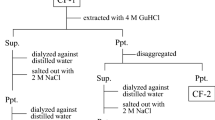Summary
The connective tissue ofApis appears to have three components: amorphous substances, fine and dense filaments and collagen-like-fibrils. These materials form the various structures comprising the connective tissiue that are: external coast or basement membranes, dense coast, neural lamellae, connective or suspending membranes, hollow strands connecting organs, filaments attaching cells, and amorphous substances cementing cells. The external coast and connective membranes are formed of only amorphous substances. The hollow strands are formed of amorphous substances, thin filaments and collagen. The neural lamellae are formed of amorphous substances and collagen and the dense coast of amorphous substances and thin filaments.
Zusammenfassung
Das Bindegewebe vonApis ist aus drei Bestandteilen zusammengestezt: aus einer armorphen Substanz, aus feinen und elektronendichten Fäden und aus Fibrillen, die dem Kollagen gleichen. Dieses Material bildet die verschiedenen Strukturen des Bindegewebes: äussere Verkleidung der Zellen bzw. der Basalmembranen, elektronendichte Hüllen, Neurallamellen, Binde- oder Aufhänge-Membranen, Hohlstränge, die Organe verbinden, Filamente, die Zellen untereinander verbinden und amorpher Substanz, die die Zellen einbetten. die Verkeleidung der Zellen und die Bindemembranen werden nur aus amorphen Stoffen gebildet, die Hohlstänge aus amorphen Stoffen, sowie aus dünnen Filamenten und Kollagen. Die Neurallamellen bestehen aus amorpher Substanz and Kollagen, die elektronendichte Verkleidungen aus amorpher Substanz und dünnen Fibrillen.
Similar content being viewed by others
References
Ashhurst (D. E.), 1961a. — A histochemical study of the connective tissue sheath of the nervous system ofPeriplaneta americana Q.J. Microsc. Sci..,102, 455–461.—Ashhurst (D. E.), 1961b. An acid mucopolyssaccharide in cockroach ganglia.Nature, 191, 1224–1225.—Ashhurst (D. E.), 1968. The connective tissues of insects.Annu. Rev. Entomol., 13, 45–74.
Ashhurst (D. E.) andRichards (A. G.), 1964. — A study of the changes occurring in the connective tissue associated with the central nervous system during pupa of the wax moth,Galleria mellonell L.J. Morph., 114, 237–246.
Baccetti (B.), 1956. — Richerche preliminare sui connective e sulle membrane basali degli insetti.Redia, 41, 75–104.—Baccetti (B.), 1961. Indagini comparative sulla ultrastructura della fibrila collagene nei dixerei ordini degli insetti.Redia, 46, 1–7.
Crus-Landim (C. da), 1975. — Extracellular crystals inApis mellifera (Hymenoptera-Apoidea).Cirênc. e Cult., 27, 276–282.
Hoyle (G.), 1952. — High blood potassium in insects in relaton to conduction.Nature, 169, 281–282.
Howse (H. D.), Ferrans (V. J.), andHibbs (R. G.), 1970. — A comparative histochemical and electron microscopic study of the surface coatings of cardiac muscle cells.J. Mol. Cell Card., 1, 157–168.
Mello (M. L. S.), Pretti (M. C. M.) andZanardi (V. A.), 1973. — The connective tissue layer of the Maplighian tubes of some blood-sucking bugs: basophilia and histophysical aspects.Studia Entomol., 1–4, 511–522.
Pipa (R. L.) andCook (E. F.), 1958. — The structure and histochemistry of the connective tissues of the sucking lice.J. Morph., 103, 353–386.
Reynolds (E. S.), 1963. — The use of lead citrate of high pH as an electron-opaque stain in electron microscopy.J. Cell Biol., 17, 208.
Treherne (J. E.), 1961a. — The efflux of sodium ions from the last abdominal ganglion of the cockroachPeriplaneta americana L.J. Exp. Biol., 38, 729–736.—Treherne (J. E.), 1961b. The kinetics of sodium transfer in the central system of the cockroachPeriplaneta americana L.J. Exp. Biol., 38, 737–746.—Treherne (J. E.), 1970. The environment and function of invertebrate nerve cells.Internat. Rev. Cytol., 28, 45–88.
Watson (M. L.), 1958. — Staining of tissue sections for electron microscopy with heavy metals.J. Biophys. Biochem. Cytol., 4, 475–478.
Wigglesworth (V. B.) andSalpeter (M. M.), 1962. — Histology of the Malpighia tubules ofRhodnius prolixus Stal.J. Insect Physiol., 8, 299–307.
Whitten (J. M.), 1962. — Breakdown and formation of connective tissue in the pupal stage of an insect.Q. J. Microsc. Sci., 103, 359–367.—Whitten (J. M.), 1964. Connective tissue membranes and their apparent role in transporting neurosecretory products in insects.Gen. Comp. Endocrinol., 4, 176–192.
Author information
Authors and Affiliations
Additional information
with financial support of FAPESP (Fundção de Amparo à Pesquisa do Estado de São Paulo) et CNPq (Conselho Nacional de Desenvolvimento Cientifico e Technológico).
Rights and permissions
About this article
Cite this article
da Cruz-Landim, C. Connective tissue ofApis mellifera: An ultrastructural study. Ins. Soc 23, 263–275 (1976). https://doi.org/10.1007/BF02283901
Received:
Accepted:
Issue Date:
DOI: https://doi.org/10.1007/BF02283901




